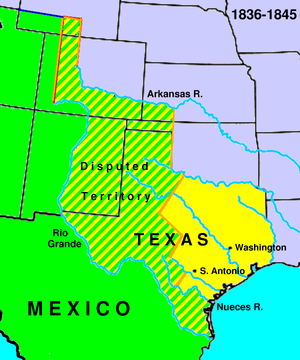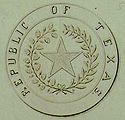Republic of Texas
- Alternative use: Republic of Texas (group)
| |||

| |||
| Official language | English (de facto) Spanish, French, German and Native American languages regionally | ||
| Capital | Washington-on-the-Brazos (1836) Harrisburg (1836) Galveston (1836) Velasco (1836) Columbia (1836) Houston (1837–1839) Austin (1839–1845) | ||
| Largest city | San Antonio de Béxar | ||
| Presidents | David G. Burnet, Sam Houston, Mirabeau B. Lamar, Anson Jones | ||
| Area | 389,166 square miles (1,007,935 km²) | ||
| Population | Approximately 70,000 (1840) | ||
| Independence | March 2, 1836 | ||
| Annexation | December 29, 1845 by the United States of America | ||
| Transfer of Power | February 19, 1846 to the State of Texas and the United States of America | ||
| Currency | Republic of Texas Dollar ($) | ||
| National anthem | Unknown | ||
The Republic of Texas was a short-lived country in North America between the United States and Mexico that existed from 1836 to 1845. Formed as a break-away republic from Mexico as a result of the Texas Revolution, the nation claimed borders that encompassed an area that included all of the present U.S. state of Texas, as well as parts of present-day New Mexico, Oklahoma, Kansas, Colorado, and Wyoming. The eastern boundary with the United States was defined by the Adams-Onis Treaty between the United States and Spain in 1819. Its southern and western-most boundary with Mexico was under dispute throughout the lifetime of the Republic, with Texas claiming that the boundary was the Rio Grande and Mexico claiming the Nueces River as the boundary. This dispute would later become a trigger for the Mexican-American War after the annexation of Texas.
History
| History of Texas | ||||||||||||||||||
|---|---|---|---|---|---|---|---|---|---|---|---|---|---|---|---|---|---|---|
 | ||||||||||||||||||
| Timeline | ||||||||||||||||||
|
||||||||||||||||||
|
| ||||||||||||||||||
- Previous article: Mexican Texas
The first Texas provisional government was formed at San Felipe de Austin on November 7, 1835. This council passed a declaration of support for the 1824 Mexican constitution, and appointed a governor and other officials. This council stopped short of declaring Texas independence. The first declaration of independence for modern Texas, by both Anglo-Texian settlers and local Tejanos, was signed in Goliad on December 20, 1835. The Convention of 1836 was convened at Washington-on-the-Brazos with Richard Ellis presiding, and the Texas Declaration of Independence was enacted on March 2, 1836, effectively creating the Republic of Texas.
Four days later, the thirteen day Siege of the Alamo ended as Mexican General Antonio López de Santa Anna's forces defeated the 183 Texans defending the small mission (which would eventually become the center of the city of San Antonio). Remember the Alamo! became the battle cry of the Texas Revolution. The Battle of San Jacinto was fought on April 21, 1836, near the present-day city of Houston. General Santa Anna's entire force of 1,600 men were killed or captured by Texas General Sam Houston's army of 800 Texans; only nine Texans died. This decisive battle resulted in Texas' independence from Mexico.
Texas claimed the Rio Grande as its southern and western limit, according to the Treaties of Velasco of May 1836. Mexico rejected the treaty as invalid and refused to recognize the existence of the Republic of Texas, although it was recognized by every other major power. Mexico insisted that Texas remained its province. Texas tried to gain recognition from Mexico as an independent state, putting the Nueces as the territorial limit in the negotiation table, to no avail. The British tried to mediate but the Mexican government refused to accept mediation. In 1845, the United States agreed to uphold Texas' claims upon the Rio Grande if it agreed to join the U.S.; Mexico threatened war if annexation took place.

Sam Houston, a native of Virginia, was President of the Republic of Texas for two separate terms, 1836–1838 and 1841–1844. He also was Governor of the state of Texas from 1859 to 1861. Houston also served as U.S. Senator from Texas following annexation of the State on December 29, 1845. Sam Houston was a Jacksonian Democrat who was considered a possible presidential candidate during his time in Wasghinton.
The first Congress of the Republic of Texas convened in October 1836 at Columbia (now West Columbia). Stephen F. Austin, known as the "Father of Texas", died December 27, 1836, after serving two months as Secretary of State for the new Republic.
In 1836, five sites served as temporary capitals of Texas starting with Velasco (Now Freeport) and also including Washington-on-the-Brazos, Harrisburg, Galveston, and Columbia (Now West Columbia) before Sam Houston moved the capital to Houston in 1837. In 1839, the capital was moved to the new town of Austin.
Internal politics of the Republic were based on the conflict between two factions. The nationalist faction, led by Mirabeau B. Lamar advocated the continued independence of Texas, the expulsion of the Native Americans, and the expansion of Texas to the Pacific Ocean. Their opponents, led by Sam Houston, advocated the annexation of Texas to the United States and peaceful coexistence with Native Americans.
The first flag of the republic was the "Burnet Flag" (which was inspired by the Bonnie Blue Flag), followed shortly thereafter by official adoption of the Lone Star Flag.
The Republic received diplomatic recognition from the United States, France, the United Kingdom, the Netherlands, and the Republic of Yucatán.
Historical Context
Texas was not the only Mexican state to secede from Mexico and declare independence. The Mexican states of Coahuila, Nuevo Leon, and Tamaulipas would also withdraw themselves from Mexico and would form their own federal republic called the Republic of the Rio Grande with Laredo as the capital, which is in the present day State of Texas. The Mexican state of Yucatán also seceded and formed the Republic of Yucatán. Several other states also went into open rebellion including San Luis Potosí, Querétaro, Durango, Guanajuato, Michoacán, Jalisco and Zacatecas. Texas, however, was the only seceding Mexican state to retain its independence.
All the Mexican states that revolted, including Texas, were upset with Santa Anna over the abolishing of the Mexican Constitution of 1824, dissolving the Mexican Congress and changing the structure of the Mexican government from a federal one to a centralized one.
See Texas Revolution for a more detailed account on what lead to the formation of the Republic of Texas.
Statehood
On February 28, 1845, the U.S. Congress passed a bill that would authorize the United States to annex the Republic of Texas and on March 1 U.S. President John Tyler signed the bill. The legislation set the date for annexation for December 29 of the same year. On October 13 of the same year, a majority of voters in the Republic approved a proposed constitution that was later accepted by the US Congress, making Texas a U.S. state on the same day annexation took effect (therefore bypassing a territorial phase). One of the primary motivations for annexation was that the Texas government had incurred huge debts which the United States agreed to assume upon annexation. In 1852, in return for this assumption of debt, a large portion of Texas-claimed territory, now parts of Colorado, Kansas, Oklahoma, New Mexico, and Wyoming, was ceded to the Federal government.
The annexation resolution has been the topic of some incorrect historical beliefs—chiefly, that the resolution granted Texas the explicit right to secede from the Union. This was a right argued by some to be implicitly held by all states at the time, up until the conclusion of the Civil War. However, no such right was explicitly enumerated in the resolution. The resolution did include two unique provisions: first, it gave the new state of Texas the right to divide itself into as many as five states with approval of its legislature. Second, Texas did not have to surrender its public lands to the federal government. While Texas did cede all territory outside of its current area to the federal government in 1850, it did not cede any public lands within its current boundaries. This means that generally, the only lands owned by the federal government within Texas have actually been purchased by the government.
Presidents and Vice Presidents
| From | To | President | Vice President | Presidential Candidates |
Pres. Votes |
Vice Pres. Candidates |
V.P. Votes |
|---|---|---|---|---|---|---|---|
| 16 Mar 1836 | 22 Oct 1836 | David G. Burnet (interim) |
Lorenzo de Zavala (interim) |
||||
| 22 Oct 1836 | 10 Dec 1838 | Sam Houston | Mirabeau B. Lamar | Sam Houston Henry Smith Stephen F. Austin |
5119 743 587 |
Mirabeau B. Lamar | |
| 10 Dec 1838 | 13 Dec 1841 | Mirabeau B. Lamar | David G. Burnet | Mirabeau B. Lamar Robert Wilson |
6995 252 |
David G. Burnet | |
| 13 Dec 1841 | 9 Dec 1844 | Sam Houston | Edward Burleson | Sam Houston David G. Burnet |
7915 3619 |
Edward Burleson Memucan Hunt |
6141 4336 |
| 9 Dec 1844 | 29 Dec 1845 | Anson Jones | Kenneth L. Anderson | Anson Jones Edward Burleson |
__ __ |
Kenneth L. Anderson |
Notable figures of the Republic

- Stephen F. Austin
- David G. Burnet
- Jim Bowie
- Edward Burleson
- Davy Crockett
- Lorenzo de Zavala
- Sam Houston
- Albert Sidney Johnston
- Mirabeau B. Lamar
- José Antonio Navarro
- James C. Neill
- Juan Seguin
- William B. Travis
- Isaac Van Zandt
- Edwin Waller
- William H. Wharton
References
- Republic of Texas Historical Resources
- Republic of Texas from the Handbook of Texas Online
- The University of Texas/history
- The State of Texas website/history
- Texas: the Rise, Progress, and Prospects of the Republic of Texas, Vol. 1, published 1841, hosted by Portal to Texas History
- Texas: the Rise, Progress, and Prospects of the Republic of Texas, Vol. 2, published 1841, hosted by Portal to Texas History
- Laws of the Republic, 1836-1838 from Gammel's Laws of Texas, Vol. I. hosted by the Portal to Texas History.
- Laws of the Republic, 1838-1845 from Gammel's Laws of Texas, Vol. II. hosted by the Portal to Texas History.
See also
- Timeline of the Texas Revolution
- History of Texas
- Republic of California
- Republic of West Florida
- Vermont Republic
External links
- The Texas Declaration Of Independence TexasBob.com.
- Republic of Texas


